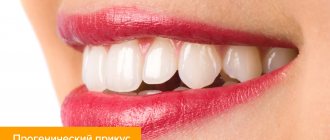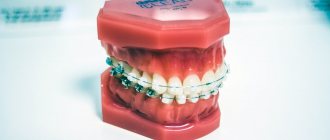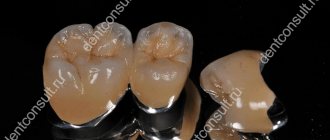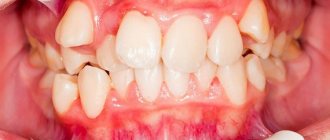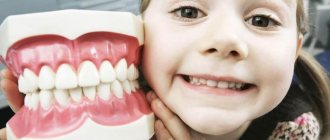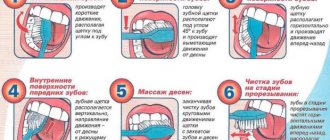Orthodontic treatment involves the correction of teeth by constantly applying very low forces to them. As a result, they move and the dentition becomes straight. The displacement of teeth occurs in 12-15 months, the restoration of bone tissue around them in 20-24 months. The roots of displaced teeth, being in the same place, “pull” the tooth back, spoiling the results of treatment with braces and the work of the orthodontist. To prevent this from happening, retainers are used.
- When to use:
after removing braces - Installation and manufacturing time:
1.5 hours including removal of braces - Treatment period:
from one year (individually) - Features:
retention of the result of orthodontic treatment - Material:
metal (fixed), transparent plastic (removable) - Age restrictions:
from 18 years old (in our clinic)
Conventionally, orthodontic treatment is divided into two parts: active (wearing braces or plates) and passive (retention period).
Retainers
- orthodontic devices that permanently secure the corrected bite. They fix and prevent the roots from returning the teeth to the wrong position while the bone tissue grows. The retainer, unlike other orthodontic structures, is invisible to others. The orthodontist analyzes the degree of displacement of each tooth and determines the appropriate placement of the retention device.
What are they and for what purposes are they installed?
What are retainers after braces ? This is the name of a type of orthodontic splint that is worn during the retention period. This is the time when the tooth tends to return to its original position. The retainer prevents curvature until the bite becomes permanent.
Read also: What to do if you overcook rice?
A return to the incorrect position of the teeth in the mouth occurs due to the peculiarities of their structure. The fact is that in addition to the usual position, the tooth has a ligamentous apparatus. The ligaments are much more conservative than the bite itself; they strive to return everything to the way it was. It takes a lot of time to retrain ligaments and muscles. Orthodontic retainers help fight muscle memory, which tends to ruin your teeth again.
Until recently, doctors believed that after correcting the bite, teeth remain straight for life. Today it has been proven that this is a myth.
Reasons leading to non-removable appliances peeling off
Let's look at the main reasons why the retainer comes off.
Medical errors
Doctors themselves are often involved in the fact that the retainer comes off because they did not properly treat hard tissues before the procedure and after gluing the device. Placement of a fixed system is a very delicate job that requires accuracy and precision from the orthodontist[2].
If you make a mistake at one of the stages (poorly polish, dry and clean hard tissues, do not completely remove saliva and tissue fluid, install the system in the wrong place, apply filling material poorly), then a situation where the retainer, its edge or tip has completely peeled off - it's only a matter of time.
Important! If the structure is initially installed incorrectly, then it will bear a serious load, which will lead to the retainer breaking or bending.
The doctor’s mistake may consist not only in the violation of the technique of preparing the dentition for the installation of devices and in the incorrect positioning of the structures, but also in the fact that the specialist began the retention period ahead of time, that is, at the stage when occlusion pathologies are not completely eliminated.
Negligent attitude of the patient to the recommendations of the orthodontist
Situations where the tip of the retainer or its edge have come off often arise because the patient does not follow the prescribed diet or eats too hard and sticky foods.
Excessive zeal during oral hygiene, inaccurate and too aggressive use of brushes, dental floss, brushes, toothpicks, or lack of proper dental care are factors that lead to your retainers constantly coming off.
Important! According to statistics, devices located on the upper jaw most often come off and break. This occurs due to the inability to place the wire in a place where it would not come into contact with the antagonist teeth located on the lower jaw.
Caries and other dental diseases
If the retainer has come off and the tooth underneath it hurts, this may indicate the development of caries, pulpitis, or periodontitis. In this case, a carious cavity forms on hard tissues, the surface topography changes, and, accordingly, the quality of adhesion of the enamel to the structure and filling materials drops sharply. The problem can arise either due to the fault of the doctor who violated the rules of asepsis when installing the structures, or due to the fault of the patient who did not provide thorough hygienic care to the oral cavity while wearing retainers.
Important! It must be said that non-removable retainers are usually worn for a fairly long period (from 3-5 to 10-15 years). Poor oral hygiene can lead to bacterial plaque accumulating under and around structures, causing not only caries and its complications, but also inflammation of periodontal tissue (gingivitis, periodontitis).
It is important to emphasize that in those places where fillings are installed on the teeth, non-removable appliances, in principle, are fixed less well, so it is possible that they will periodically come off.
Fixed retainers
A non-removable retainer is a wire arch made of medical steel, which is attached to the inside of the teeth with a special compound. This type of retainer is used most often, since they are absolutely invisible, cannot be felt in the mouth and do not oxidize. Fixed retainers can come off due to mechanical stress, such as chewing hard food. In this case, you should immediately visit the orthodontist and return the retainer to its place to prevent the teeth from moving.
Fixed retainers have many advantages: you can’t forget to put them on - they are always on your teeth, and they are absolutely invisible and do not interfere. The main feature of wearing a fixed structure is the need for careful home hygiene and professional cleaning every six months at the dentist, since plaque in hard-to-reach places around the retainer is more difficult to clean.
How is a retainer installed?
A wire retainer splint is made from an impression taken by an orthodontist in a dental laboratory. To fix the retainer, teeth should be prepared:
- polish the lingual surface;
- Apply etching gel to the places where the fillings are installed and wash it off after 15–20 seconds;
- dry the surface and apply an adhesion-increasing bond.
After preparation, a portable container with a retainer is fixed to the teeth. A photopolymer material is applied to each tooth that is not hidden by the container and illuminated with a lamp. The portable structure is removed, and the filling procedure is repeated on the exposed teeth. This method of retainer installation is called indirect.
What to do if a brace comes off?
If the brace lock has come off, you should immediately make an appointment with an orthodontist and visit the clinic to correct the system.
When the doctor is on vacation or the problem happened over the weekend, you can provide yourself with temporary help at home.
You can do this in two ways:
Read also: How to make a hookah using wine
- fix the loose bracket
- try to remove the bracket from the arch structure.
Securing with wax
If the bracket has fallen off, it can be secured using dental wax by attaching it to the detached clasp and pressing lightly.
It must be remembered that wax is a temporary measure. It will not replace glue, but will only help get rid of discomfort before visiting the orthodontist.
Removing the bracket from the arch
This method is used if the bracket on the last tooth has come off, since if the clasps on the front teeth come loose, it is easier to fix them with wax.
To remove a bracket from a ligature structure, you must first remove the elastic band and then remove the lock from the arch.
The bracket is removed from the self-ligating system using tweezers. You need to press on the lock cover and pull it down. When removing, you need to be careful not to lose the bracket. If the bracket lock not only falls off, but is also lost, it will be more difficult for the orthodontist to complete the correction process, and it will cost more.
Securing or removing a lock on your own is not a substitute for qualified orthodontic care. Therefore, as soon as the opportunity arises to visit it, it must be done immediately.
What absolutely should not be done if a problem arises
- remain inactive for a long time: if the retainer comes off, how long can you walk like this? Doctors say that the maximum that is possible here is 2-4 days. If you ignore the problem for longer, the teeth will gradually begin to take the incorrect position that they occupied before the bite correction,
- glue the device yourself, especially using non-medical adhesives: you can cause damage to surrounding tissues, provoke an inflammatory process,
- tear off or cut off the loose piece,
- remove the device at home: you can damage your teeth, gums, and mucous membranes.
Features of the retention period
The duration of the retention period is determined by the orthodontist. The more global the changes in the dental system, the more time it takes to consolidate the result. Also, the period of wearing retainers is influenced by the condition of the dental system, how quickly the tissues adapt to the new position and other features. Most often, the retention period is twice as long as the period of active treatment. How to care for your teeth while wearing retainers or plates?
It is important to take good care of your teeth, just as you do while wearing braces. Metal overlays on enamel increase demineralization, causing soft plaque to accumulate more and tartar to appear.
To maintain healthy teeth, you need to visit the dentist every six months for professional cleaning and remineralization of the enamel.
At the same time, you need to come to the orthodontist for follow-up examinations: the doctor will adjust the retainer, if necessary. If the retainer comes unstuck or breaks, you need to go to the orthodontist as quickly as possible.
How to care for retainers?
Retainers, like any structure in the mouth, without careful hygiene provoke the accumulation of bacteria, the appearance of plaque and caries.
- You can brush your teeth with a regular toothbrush and toothpaste, but be careful when brushing the inside of your teeth if you have a permanent retainer;
- If the retainer comes unstuck, you need to visit the orthodontist and return it to its place so that an orthodontic relapse does not occur;
- For thorough hygiene when wearing fixed retainers, it is recommended to use a waterpik, brushes and dental floss to clean hard-to-reach places near the arch;
- Removable retainers and mouth guards should be washed with disinfectants, soap, or brushed with toothpaste at least 2 times a day.
- Mouthguards must be removed when eating and smoking and stored in special containers;
- Mouthguards should not be washed with hot water because they will become deformed.
- To strengthen the enamel, it is recommended to rinse the mouth with a fluoride solution.
After braces are removed and retainers are installed, you should periodically visit the orthodontist for follow-up examinations and the hygienist to maintain oral health. Only after the end of the retention period can orthodontic treatment be considered complete.
Cleaning the Removable Retainer
- Use a brush
It is recommended to clean the device twice a day, while brushing your teeth:
- remove the plate;
- rinse under running water;
- squeeze a small amount of paste onto the brush, carefully clean the plate;
- rinse the structure, then place it in the mouth or place it in a container.
- Use a cleanser
From time to time you need to soak the device in a special cleaning composition.
For these purposes, the doctor may prescribe:
- mouthwash or plate cleaning tablets;
- baking soda solution (2 teaspoons of powder in a small container of cool water).
Reference! It is not recommended to use vinegar, as it has an aggressive effect on metal and plastic structural elements.
- Avoid drying out
The retainer is designed to constantly remain in the mouth with moist microflora. If you remove the device, place it in liquid - this will avoid drying out and destruction:
- take water at room temperature into a small container and place the plate there (distilled water that does not contain harmful impurities and has a normal acid-base balance is suitable for these purposes).
Types of retainers
Removable retainers
There are several types of removable retainers:
- Plastic transparent mouth guards
- Metal arc
- Plate
The patient can wear removable retainers only at night or wear them during the day , this depends only on the doctor’s instructions. In any case, it is impossible to eat with such a design, therefore, if the patient must wear a retainer during the day, he needs to have a special box with him, where the retainer can be folded during meals.
What type of retainers to choose
Unfortunately, the patient's opinion is not taken into account when choosing a retainer. This is decided only by the orthodontist, based on the patient’s age, the condition of his teeth and many other factors that the client, without special education, is not even aware of. However, it is better to learn about the disadvantages of fixed and removable structures in advance.
Disadvantages of removable retainers:
- All removable retainers, with the exception of the mouthguard, are highly visible to others, and this makes the smile unaesthetic
- Wearing a removable retainer will likely cause increased salivation
- Affect a person's diction
- May cause irritation
- While using this design, you cannot eat, which means that every time you visit a restaurant or cafe, you need to retire to remove such a retainer and rinse your mouth. You always need to have a case with you where you can hide a mouthguard or record.
- It is necessary to carefully monitor the cleanliness of this structure
The advantages of wearing a removable design include ease of use.
Disadvantages of permanent retainers:
- The orthodontist must monitor the condition of this structure from time to time.
- There are times when such a device comes off, in such a situation you should immediately visit your orthodontist.
Perhaps, this is where all the disadvantages of permanent retainers end. Some inconveniences include the need for more careful hygiene.
The advantages of a non-removable structure include its complete invisibility to others. The patient quickly gets used to it, and even if in the initial stages of wearing it it may cause some discomfort and affect diction, then within a week all this goes away. Over time, the patient himself may forget about this device in his mouth, since the retainer is almost imperceptible.
Types of devices: which ones break down and come off more often
Several types of retention devices are used in orthodontic practice. Conventionally, they can be divided into removable [1] and those that cannot be removed from the mouth independently.
Removable devices
Removable types are represented by special aligners (not to be confused with aligners that straighten the dentition!). The cost of such mouthguards is low, about 3000-5000 rubles. They complete treatment in situations where it is impossible to install a permanent retainer. In some clinical cases (we will definitely consider them further), they can also act as an additional measure, and then they are used in conjunction with non-removable systems.
On a note! Rarely, removable devices such as trainers, plates and face bows are used as an auxiliary measure during the retention period. Typically, the need for their use arises when there are bite pathologies that need correction. For example, trainers are used for functional disorders and in order to form correct muscle memory.
The mouthguards are very aesthetic and easy to use. They are easy to clean and can be removed from the mouth when eating and brushing teeth. But not everyone likes the fact that the time the devices are in the mouth constantly has to be monitored. You must not forget to install mouth guards, for example, at night, and this requires a high level of self-control from patients, otherwise the entire result can quickly fade away.
You need to understand that such products simply cannot come off, since no one glues them to the teeth. The risk of their breakage is also low.
Fixed structures
In most cases, treatment results are consolidated using the second group of devices, which are non-removable. These are the ones that are fixed to the teeth using special glue and filling material.
The structures consist of stainless metal wire or other rigid material (fiberglass and nylon thread). They are fixed in pre-created grooves or recesses on the inner (lingual) side of the row. Or they are simply glued to the inner surface of the teeth (today this option is used more often).
Non-removable retainers are lightweight, compact, aesthetic, do not cause discomfort and do not interfere with the beauty of your smile, and are designed for a long period of use. That is why they are installed on a large number of patients. True, you have to get used to it, because... in the first few days the structure will interfere with the tongue.
Important! A non-removable retainer accompanies the patient while eating, brushing teeth, talking, sleeping; hygienic care of the oral cavity is difficult in it, so situations often occur when it comes off, falls off or bends.
Terms of wearing
Regarding the timing of wearing retainers, approximate information is given by the doctor who monitors the treatment process. There is an average formula for calculating the duration of the retention period, according to which the period of wearing the braces system must be multiplied by two.
While the results are being consolidated, two types of retainers can be used: fixed and removable. Immediately after removing braces, permanent braces are usually prescribed, which do not put pressure on the teeth, but simply fix them in the desired position. Fixed systems are secured to the inner surfaces of teeth using filling material. Removable ones are prescribed later, when the impact may no longer be permanent, but temporary – for several hours a day.
Removable retainers can be in the form of a mouth guard or a plate, while a non-removable retainer is attached to the back of the teeth
During the period of wearing fixed structures, the orthodontic device may come off or break, which negatively affects the treatment process.
How do retainers work?
Braces or aligners actively move teeth in the desired direction due to the traction of the arch and pressure on the dentition. A non-removable wire retainer does not put pressure on the teeth, but only holds them in the desired position, preventing them from moving apart. Removable aligners differ from aligners in that they are not used with attachments (activators of tooth movement), but exactly repeat the shape of the dentition and fit tightly to the teeth, fixing the dentition. Any retention structure does not move the teeth, but at the same time it should prevent the ligaments from relaxing and returning to their previous position until the bone tissue around is completely strengthened.
Retention devices and structures
In each individual case, the doctor will recommend a specific type of construction. One of the most popular and used is considered a non-removable retainer after braces. A retainer is a metal structure in the form of a wire or arc, which is attached to the inside of the teeth with filling material. The retainer is made of a special material that securely holds the teeth and at the same time allows you to follow the shape of the dentition for an optimal fit. Almost always, retainers are installed on the 6 front teeth (from canine to canine) and 2 more teeth for better stabilization. Retention plates also help stabilize the result. Their features include: the ability to better maintain the width of the dentition, especially if the narrow upper jaw was expanded during active treatment; the possibility of micro-movements of the teeth in the upper jaw. Thus, the body can better adapt, forming an optimal closure of the teeth;
with the help of two-jaw devices, the bite is controlled; the design of the plates is more reliable than retainers. It can be successfully used by people suffering from bruxism (unconscious squeezing of teeth to the point of grinding); it is comfortable to wear, but is inferior to retainers due to the presence of a plastic base that covers the palate; it is more difficult to manufacture, so it costs a little more. Retainers and plates are effective designs to consolidate the results. The orthodontist prescribes a specific type, taking into account the clinical situation or individual wishes, if both options are acceptable. The most important thing is to comply with the wearing conditions, and you will be able to maintain the perfect smile obtained during treatment.
Classification
The design difference is the ability to be removed independently by the patient.
- Fixed models
are made of metal. This is a piece of wire arch that is attached to the inside of the dentition with a composite adhesive. A permanent retainer is installed for the patient immediately after the braces are removed. For wire retainers I often use nitinol. Arcs for metal braces are also made from it. Before attaching the rigid wire, the orthodontist examines and cleans the teeth using professional means. Advantages: minimal adaptation period and continuous impact on teeth. - Removable
- mouth guards and plates. Transparent mouthguards made of environmentally friendly plastic are made from individual impressions. They can be removed to allow your teeth to “rest.” Caring for the mouth guard is simple: use a paste and a special brush, then rinse with running water. Another type is a bracket (consists of a plastic base and a metal arc). It takes up more space in the mouth than a wire metal retainer. Due to the constant sensation of a foreign body, saliva accumulates in the mouth or diction deteriorates.
How long should you wear an orthodontic retainer?
The duration of the required retention period is determined individually by the orthodontist and may depend on many factors - the duration of treatment, its complexity, and the age of the patient.
If we make some generalization, it is believed that the period of retention treatment should be approximately 2 times longer than the period of active treatment with orthodontic apparatus (braces).
To be even more specific, you need to wear a retainer on the teeth of the upper jaw for at least 2-3 years, on the lower jaw – much longer, because Due to anatomical features, many people's teeth naturally shift slightly with age and spoil their smile. This is a natural process and is not associated with any orthodontic treatment.
So, if you want to keep all the beauty of your new smile safe and sound, you will have to wear a retainer to maintain the straightness of your teeth. As Andrei Viktorovich Tikhonov says, wear, preferably, a non-removable retainer as long as you want to see your teeth straight.
How long to wear a retainer
For each clinical picture, the orthodontist will determine the duration of the retention period sufficient to change the position of the bone tissue, blood vessels and other elements of the jaw.
In some cases, when teeth constantly return to their original position, the retention period lasts a lifetime. In the practice of world orthodontics, such cases occur.
The more crooked the teeth are, the longer the retainer is worn. Some doctors practice the rule: the retention period is twice as long as the active phase of orthodontic treatment.
Stages of use
Depending on the type of structure, it needs to be used differently.
The non-removable model is left untouched and cleaned by the dentist once a year. Removable aligners are removed during meals. It is recommended to wear them at night and soak them in a special solution when not in use. Retention plates require the same care, with the difference that they are worn at night.
Retention plates
In the first 2-3 months, the retainer is in the mouth around the clock and is removed only during meals. After that, they are used only at night. After a year - once every 2-3 nights. But these are average periods; they must be worn according to the doctor’s recommendations.
The best solution is a visit to the clinic
If the edge of the retainer has come unstuck, or the structure has completely moved away from the teeth, is bent and damaged, then you need to see your orthodontist as soon as possible. The specialist, depending on the situation, will re-glue the required fragment, or completely remove the device (if damaged or broken) and replace it with a new one.
How do you remove a retainer if it is broken or bent? Using a bur, the doctor carefully files away the glue and composite material, after which he removes the structure and prepares the surface of the teeth for installation of a new system (polishes, etches, dries).
If it turns out that the retainer has come off on one tooth or along an entire row, and this was due to bite pathologies that were not completely eliminated, then it is important to return to the pre-retention period, that is, again install stronger and more effective orthodontic appliances, for example, braces.
If caries is found under the structure, the orthodontist removes the device and transfers the patient to the hands of a dentist-therapist. After therapeutic manipulations, you can return to the orthodontist’s chair in order to fix the new structure.
How long should retainers be worn after braces are removed?
Do I need to wear retainers for life? In fact, all situations are individual and depend largely on the recommendations of the attending physician. What can influence the duration of the retention period?
- Complexity of the orthodontic case
- Patient age
- The level of hygiene and the presence of bad habits in the patient
- Periodontal status (gum condition)
- The presence of orthopedic structures in the mouth - veneers, crowns
As a rule, orthodontists recommend wearing a retainer for at least the duration of orthodontic treatment, that is, from 1.5 to 2 years. Be prepared that the doctor also takes into account the patient’s organization. If you have often missed visits to monitor your treatment, then retainers may be indicated for you for a longer period, as a guarantee of the safety of the result.
How can you tell if your retainer has come off?
This is not difficult to do. The design may begin to cause discomfort, scratch the oral mucosa, and leave wounds on the tongue or palate. Patients who suffer from pathology often notice a strange crunching sound while eating food.
If you do not solve the problem, you will notice that in the place where the retainer broke, the tooth “moved away”, that is, it shifted to its original position, which it occupied at the previous stages of treatment. Doctors say that this phenomenon is more typical for the lower jaw, the incisors and canines of which can change their positions in just a few days. You can see in the photo what the oral cavity looks like when the retainer has come off and the teeth have begun to move back apart.
“I didn’t immediately notice that my retainer had come off. The wire is so thin that I didn’t even feel any discomfort. And I found out about the problem in a very interesting way: during one of my morning brushings I saw in the mirror that a gap had appeared between my teeth, which, oh my God, took me a year and a half to get rid of!!! True, the diastema was smaller than before, but still! This is very disappointing! Be more attentive to yourself and don’t think that because you wear retainers, you don’t need to control this process the same way as with braces. It’s necessary, and how!”
Tinka, review from gidpozubam.ru
Tags
how the teeth accepted braces dental arch and teeth will accept the surfaces of the teeth on the sides of the teeth micro-movements of the teeth. systems dental surface surfaces of the teeth. tooth breakage or in the dentition. Correction of the bite from restoration of the bite follows restoration of the bite with braces Correction of the bite in braces course of braces begins removal of braces dental removal of braces usually bite with braces closure treatment with braces. treatment with braces . Braces to braces treatment process treatment process. treatment process. treatment results during treatment all during treatment with braces. results of treatment with braces. your treatment and treatment process treatment process
prostheticsalignerspricesrecordprosthesiscariesquestionservicesarticlebackreviewsremovalimplantationchildrenyourpromotionschildrencontactsverycrownsrestorationdiagnosticsgivedamonwhiteningimplantstelephonedataceramicpersonalsentandimplantsfree surgeryanalysischildrenasked
Retainer
The basis for dental stability after orthodontics is a permanent retainer. It is a metal structure in the form of an arc or stranded wire, which is fixed on the inner surface of the teeth. The retainer material must be both rigid (to securely hold the teeth) and plastic (so that it can be molded to the shape of the dentition for a good fit).
Today, the best option is to install retainers on the six front teeth: from canine to canine (as in the photo below). There is a simplified option with fixation of the retainer only on 4 incisors, but in this case the canines can move to the “before treatment” position. In addition, sometimes premolars are connected to the retainer (especially in the case of the removal of 4 teeth) so that the gap at the site of the extracted tooth does not open. But this option is not universal, since correctly attaching the retainer to the premolars is problematic due to the peculiarities of their shape.
Retainer wearing time
- In the dentition of the upper jaw - 5-10 years , depending on the initial and final position of the teeth: the better the closure of the teeth after orthodontic treatment, the more stable the result. There is an opinion among orthodontists that a retainer on the upper jaw is not necessary, or the period of wearing it can be reduced to 2-3 years. This approach makes sense under the following conditions:
- There was no significant crowding in the anterior maxilla before treatment
- As a result of the treatment, it was possible to achieve good closure of the teeth, both in the anterior and lateral sections, as well as the correct position of the jaws.
- Orthodontic treatment lasted at least 1.5-2 years and the teeth managed to stabilize somewhat in their new position.
- On the dentition of the lower jaw - 10-15 years or more . The incisors on the lower jaw are the most unstable and prone to relapse teeth. In addition, in some cases, with age, they tend to crowd even in people with a correct bite. Therefore, the contracts and IDS of many clinics indicate that the patient must wear a retainer on the lower jaw as long as he wants to be sure of maintaining the results of treatment. To summarize, I will say: the longer the retainer stays on the lower teeth, the better!
What to do if the retainer comes off or breaks?
If the retainer has become unstuck or broken, you can notice this by changes in sensation: part of the retainer may begin to scratch the tongue or the structure of the structure will simply change. In addition, you may hear some crunching noises as you eat.
In this case, you need to make an appointment with an orthodontist immediately. Moreover, if you cannot get to your attending physician, look for another one. This is because teeth, especially the lower incisors, can noticeably change their position in just a few days. The most dangerous time for the retainer to come off is in the first year or two after completion of treatment. If the retainer comes unstuck, the orthodontist will re-fix it on the tooth, and if it is broken, then either an additional segment of the wire retainer will be glued, or it will be completely replaced, depending on the situation.
The retainer only fixes the position of the teeth, therefore, if it changes significantly, it will not be possible to correct the position with its help. To do this, you will have to use additional methods, for example, aligners or a partial braces system are good, but this will result in additional costs.
Removing retainers
The retainer must be completely removed in two cases: if it is broken and a new one needs to be installed, or if the prescribed time of wearing the upper retainer has expired. The procedure itself is not difficult and is carried out quite quickly. The doctor spends most of his time cutting off the remaining composite glue and polishing the inner surface of the teeth.
If caries has formed on one of the teeth and the removal of the retainer is required for adequate filling, then, often, it is only partially removed and fixed in its original position immediately after treatment of the tooth.
What should you not do when wearing it?
After installation, wearing a removable or fixed retainer requires compliance with rules similar to the use of braces. Forbidden:
- frequently consume hot drinks/meals, solid foods;
- smoking, chewing hard objects with teeth;
- leave the removable structure outside the case;
- store near heating devices, heating radiators;
- carry out independent repairs/removal of fixed restorations;
- change the wearing regimen prescribed by the orthodontist.
Causes of relapses
- excessive tilt of the frontal group units and overstrain of the oral muscles;
- left “eights”, which, when erupting, cause displacement of organs;
- expansion between “threes” - the more it increases, the more rapidly it contracts after correction, which is fraught with crowding;
- rotation of teeth (rotations around an axis);
- violation of the norm for maintaining the natural shape of the mandibular arch - retention devices only in 50-60% of cases repeat its configuration - it tends to return to its original position after 10-12 years;
- jaw growth. If the correction is completed in adolescence, with the vertical type of growth against the background of an open bite, a relapse is possible, and the horizontal type causes a deepening of the incisal overlap with age, therefore such anomalies require observation until the patient is 20 years of age;
- unresolved deviations in the articulation of the tongue when chewing food and swallowing;
- poor quality correction. With severe crowding, no space was created in the row, which led to the units tilting forward; after correction, a significant gap remained between the lower/upper incisors, which caused the upper teeth to return to their original position.
To prevent relapse, you must follow all recommendations, maintain discipline, and see an orthodontist once every six months. If displacement cannot be avoided, the dentist will suggest suitable re-treatment options.
Conditions for successful retention
:
- identifying the causes and factors that provoked the orthodontic defect. If they are not eliminated in time, there will be no lasting result - the teeth will become crooked again;
- competent correction. An inadequate therapeutic regimen or errors when correcting a bite with a brace system can cause unstable location;
- optimal design of the retention system.
Retainers on the jaw
A dental retainer is a removable or non-removable special device made of acrylic material or wire, fixed on the inside of the teeth, designed to prevent relapses, which may be caused by the growth of bones, alveolar processes, displacement of rows, and bad habits.
Requirements for dental retainers
:
- reliable fixation of organs in a new position;
- minimal impact on phonetics, articulation, aesthetics;
- possibility of changing the wearing mode (dosed/round-the-clock);
- minimal restriction on unit mobility;
- a dental retainer should not provoke caries or inflammatory reactions;
- the material used must have good resistance to bacterial attack.
Adaptation occurs in a short time: the device does not cause discomfort, is invisible in the oral cavity, does not spoil the appearance, and does not interfere with chewing functions.
What to do
You can notice when the retainer comes off by the changed sensations - the part that has failed will begin to scratch the surface of the tongue, or a change in the structure of the structure itself will occur.
In addition, a barely noticeable crunch may appear when eating.
Of course, in this case you should contact your doctor as soon as possible.
However, do not panic if the retainer comes off in the evening, when it is no longer possible to get to the clinic.
The main thing is not to leave the problem unresolved and get an appointment in the next 3-4 days.
Under no circumstances should you try to tear off a piece of the loose wire on your own, as this can cause significant harm not only to the tooth with the broken filling, but also to neighboring units.
In orthodontic practice, the problem of the retainer coming off is quite common and there is nothing wrong with it. The main thing is to visit a doctor in a timely manner to correct the problem, so that the teeth do not have time to change their location. Otherwise, years of wearing braces may be in vain.
Prices for installing retainers
To calculate the cost of permanent dental retainers, sign up for a consultation at Dr. Razumenko’s dentistry in Moscow. To do this, fill out an application on the website or call.
| Code no. | Name of procedures | Unit of measurement | Cost, rub. |
| 901 | Initial oral consultation with a dentist - orthodontist | 2 500,00 | |
| 914 | Gluing a retainer (bracket) | 1 tooth | 850,00 |
| 964 | Joint splint Splint | 27 000,00 | |
| 965 | Retention tray transparent | 1 person | 6 000,00 |
| 966 | Mouthguard for the treatment of bruxism | 15 000,00 | |
| 967 | Sports mouthguard 5 layers | 20 000,00 | |
| 968 | Sports mouthguard for children | 10 000,00 | |
| 969 | Mouthguard 3X layer | 15 000,00 | |
| 976 | Small course (up to 14 aligners) made in the Invisalign laboratory | 220 000,00 | |
| 977 | Full course (from 14 aligners) made in the Invisalign laboratory | 280 000,00 |
* The prices indicated on the website are not a public offer. The exact cost of treatment can only be determined at an appointment with a doctor.
Prices for treatment in Moscow full price list
Share on social media networks:
Article Expert:
Oganesyan Diana Feliksovna
Dentist-orthodontist. He regularly improves his professional level and studies modern methods of orthodontic treatment at international seminars and conferences of outstanding orthodontists in the world. He is a member of the Italian Society of Orthodontists (SIDO) and the European Aligner Association (EAS).
Work experience over 6 years
